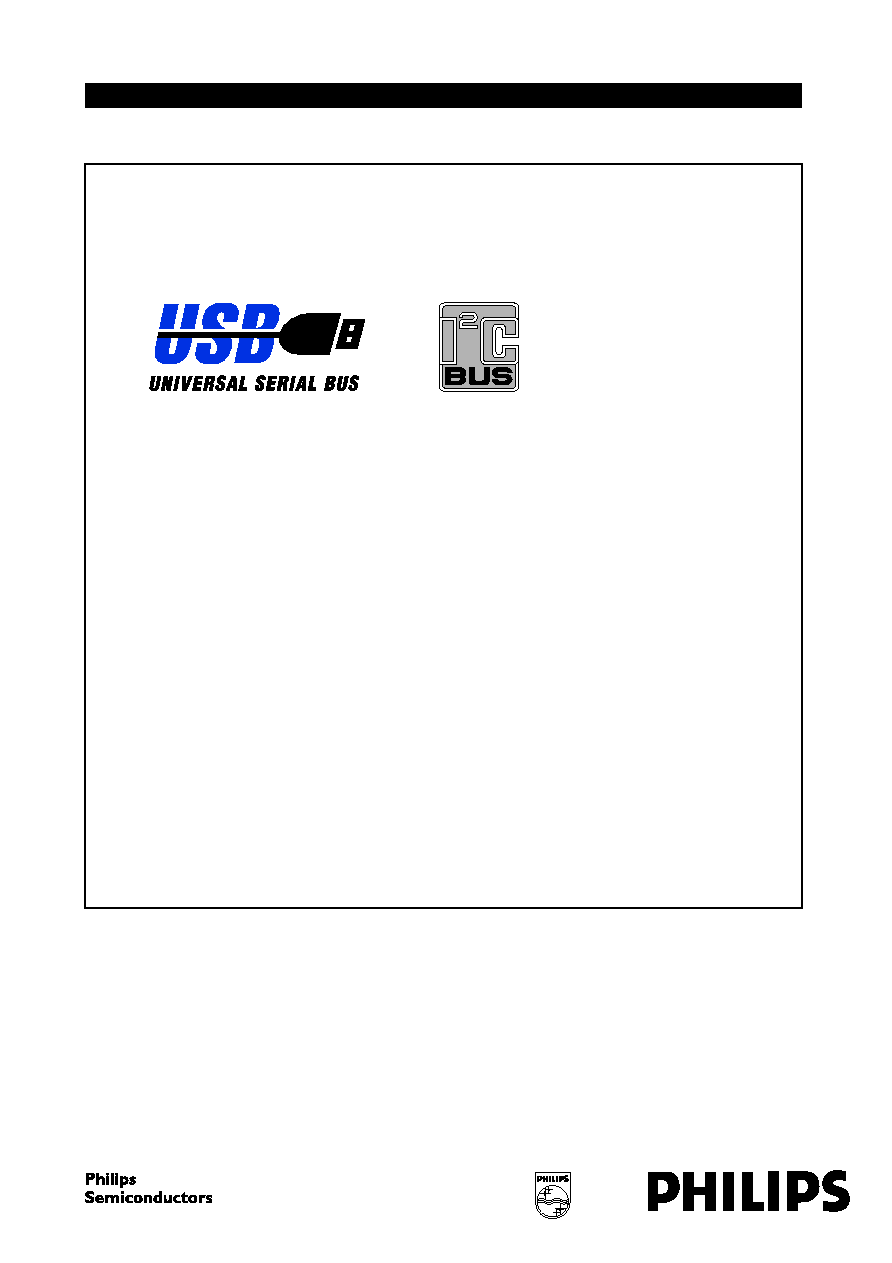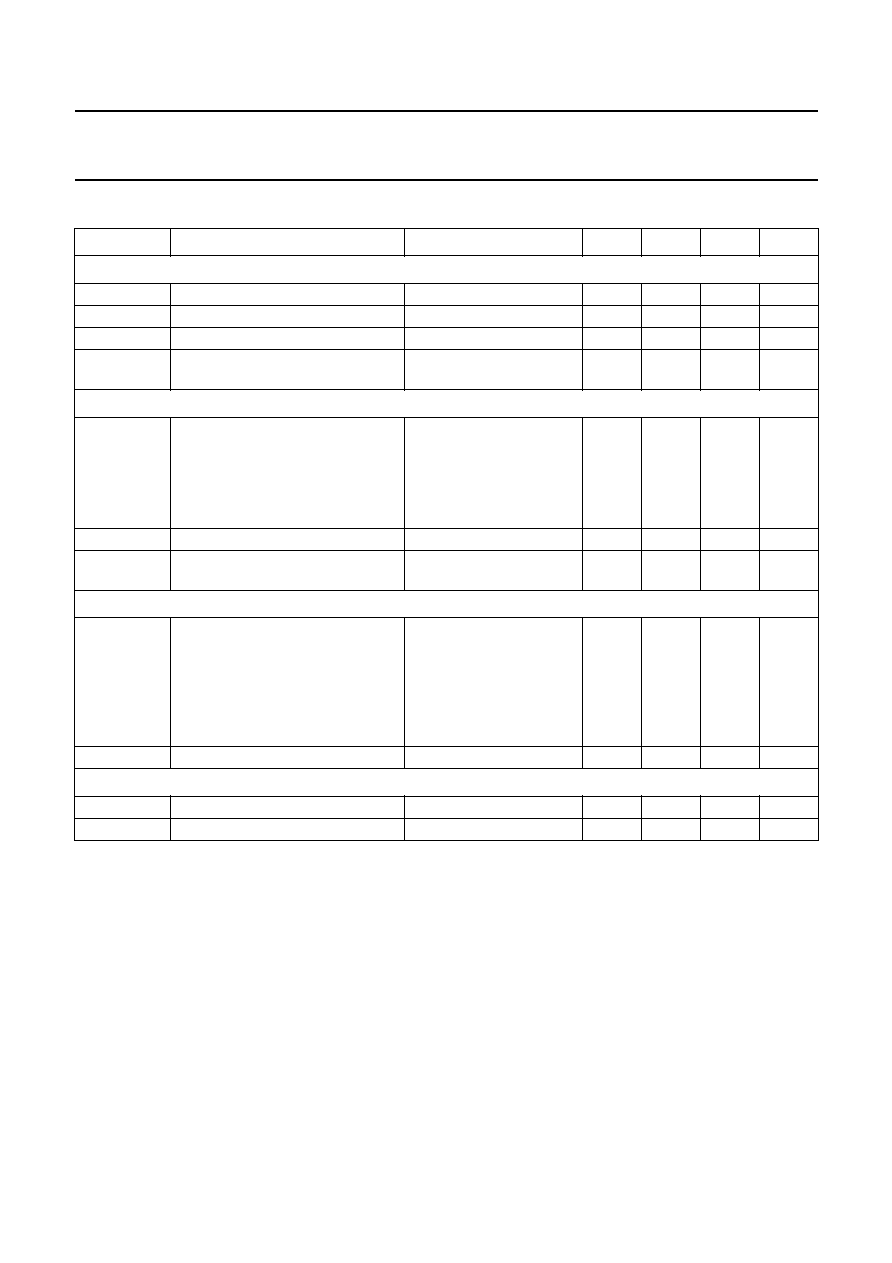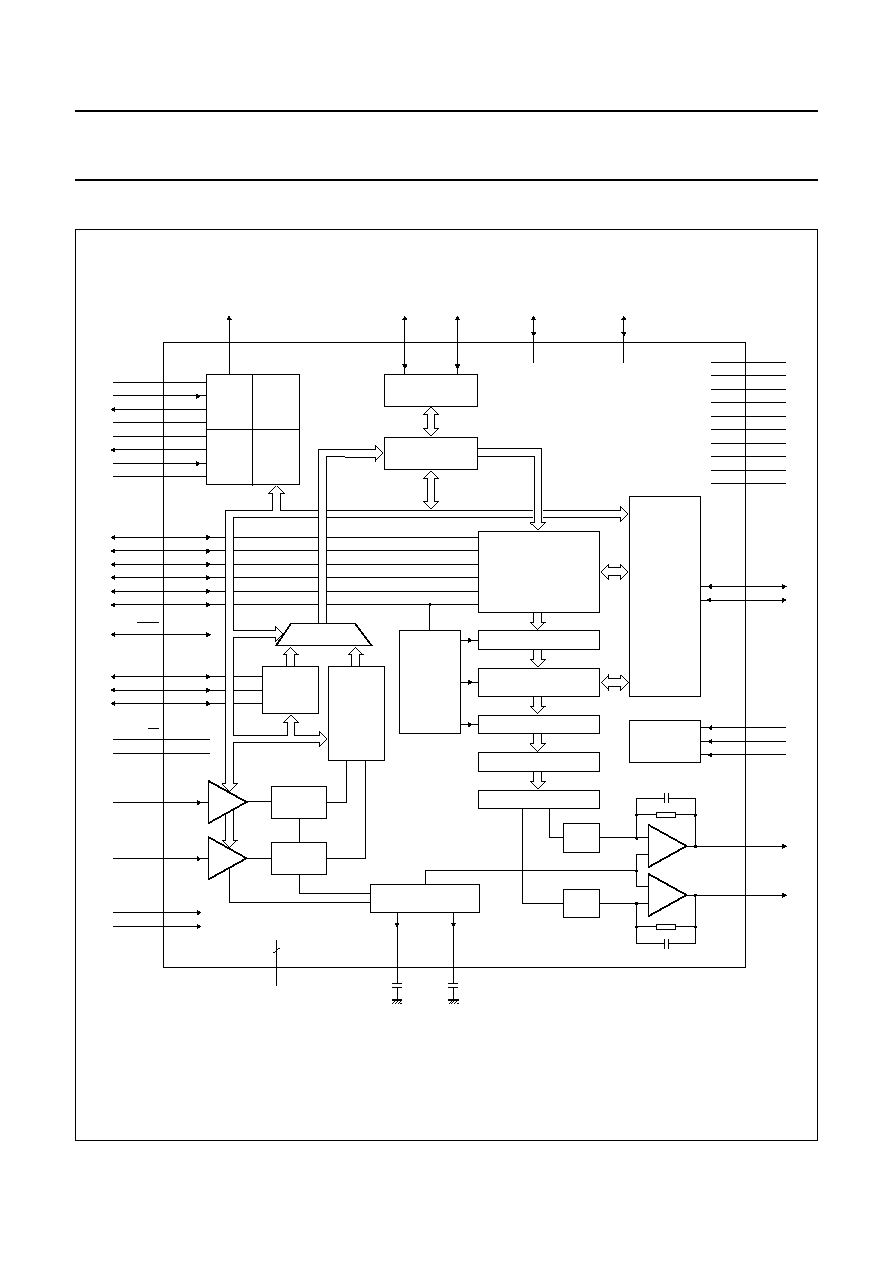Universal Serial Bus (USB) CODEC

DATA SHEET
Preliminary specification
File under Integrated Circuits, IC01
1999 May 10
INTEGRATED CIRCUITS
UDA1325
Universal Serial Bus (USB) CODEC

1999 May 10
2
Philips Semiconductors
Preliminary specification
Universal Serial Bus (USB) CODEC
UDA1325
FEATURES
General
·
High Quality USB-compliant Audio/HID device
·
Supports 12 Mbits/s serial data transmission
·
Fully USB Plug and Play operation
·
Supports `Bus-powered' and `Self-powered' operation
·
3.3 V power supply
·
Low power consumption with optional efficient power
control
·
On-chip clock oscillator, only an external crystal is
required.
Audio playback channel
·
One isochronous output endpoint
·
Supports multiple audio data formats (8, 16 and 24 bits)
·
Adaptive sample frequency support from 5 to 55 kHz
·
One master 20-bit I
2
S digital stereo playback output,
I
2
S and LSB justified serial formats
·
One slave 20-bit I
2
S digital stereo playback input,
I
2
S and LSB justified serial formats
·
Selectable volume control for left and right channel
·
Soft mute control
·
Digital bass and treble tone control
·
Selectable on-chip digital de-emphasis
·
Low total harmonic distortion (typical 90 dB)
·
High signal-to-noise ratio (typical 95 dB)
·
One stereo Line output.
Audio recording channel
·
One isochronous input endpoint
·
Supports multiple audio data formats (8, 16 and 24 bits)
·
Twelve selectable sample rates (4, 8, 16 or 32 kHz;
5.5125, 11.025, 22.05 or 44.1 kHz; 6, 12, 24 or 48 kHz)
via analog PLL (APLL).
·
Selectable sample rate between 5 to 55 kHz via a
second oscillator (optional)
·
One slave 20-bit I
2
S digital stereo recording input,
I
2
S and LSB justified serial formats
·
Programmable Gain Amplifier for left and right channel
·
Low total harmonic distortion (typical 85 dB)
·
High signal-to-noise ratio (typical 90 dB)
·
One stereo Line/Microphone input.
USB endpoints
·
2 control endpoints
·
2 interrupt endpoints
·
1 isochronous data sink endpoint
·
1 isochronous data source endpoint.
Document references
·
"USB Specification"
·
"USB Device Class Definition for Audio Devices"
·
"Device Class Definition for Human Interface Devices
(HID)"
·
"USB HID Usage Table".
·
"USB Common Class Specification".

1999 May 10
3
Philips Semiconductors
Preliminary specification
Universal Serial Bus (USB) CODEC
UDA1325
APPLICATIONS
·
USB monitors
·
USB speakers
·
USB microphones
·
USB headsets
·
USB telephone/answering machines
·
USB links in consumer audio devices.
GENERAL DESCRIPTION
The UDA1325 is a single chip stereo USB codec
incorporating bitstream converters designed for
implementation in USB-compliant audio peripherals and
multimedia audio applications. It contains a USB interface,
an embedded microcontroller, an Analog-to-Digital
Interface (ADIF) and an Asynchronous Digital-to-Analog
Converter (ADAC).
The USB interface consists of an analog front-end and a
USB processor. The analog front-end transforms the
differential USB data into a digital data stream. The USB
processor buffers the incoming and outgoing data from the
analog front-end and handles all low-level USB protocols.
The USB processor selects the relevant data from the
universal serial bus, performs an extensive error detection
and separates control information and audio information.
The control information is made accessible to the
microcontroller. At playback, the audio information
becomes available at the digital I
2
S output of the digital I/O
module or is fed directly to the ADAC. At recording, the
audio information is delivered by the ADIF or by the digital
I
2
S input of the I
2
S-bus interface.
All I
2
S inputs and I
2
S outputs support standard I
2
S-bus
format and the LSB justified serial data format with word
lengths of 16, 18 and 20 bits.
Via the digital I/O module with its I
2
S input and output, an
external DSP can be used for adding extra sound
processing features for the audio playback channel.
The microcontroller is responsible for handling the
high-level USB protocols, translating the incoming control
requests and managing the user interface via general
purpose pins and an I
2
C-bus.
The ADAC enables the wide and continuous range of
playback sampling frequencies. By means of a Sample
Frequency Generator (SFG), the ADAC is able to
reconstruct the average sample frequency from the
incoming audio samples. The ADAC also performs the
playback sound processing. The ADAC consists of a
FIFO, an unique audio feature processing DSP, the SFG,
digital filters, a variable hold register, a Noise Shaper (NS)
and a Filter Stream DAC (FSDAC) with line output drivers.
The audio information is applied to the ADAC via the USB
processor or via the digital I
2
S input of the digital I/O
module.
The ADIF consists of an Programmable Gain Amplifier
(PGA), an Analog-to-Digital Converter (ADC) and a
Decimator Filter (DF). An Analog Phase Lock Loop (APLL)
or oscillator is used for creating the clock signal of the
ADIF. The clock frequency for the ADIF can be controlled
via the microcontroller. Several clock frequencies are
possible for sampling the analog input signal at different
sampling rates.
The wide dynamic range of the bitstream conversion
technique used in the UDA1325 for both the playback and
recording channel guarantees a high audio sound quality.
ORDERING INFORMATION
TYPE NUMBER
PACKAGE
NAME
DESCRIPTION
VERSION
UDA1325PS
SDIP42
plastic shrink dual in-line package; 42 leads (600 mil)
SOT270-1
UDA1325H
QFP64
plastic quad flat package; 64 leads (lead length 1.95 mm);
body 14
×
20
×
2.8 mm
SOT319-2

1999 May 10
4
Philips Semiconductors
Preliminary specification
Universal Serial Bus (USB) CODEC
UDA1325
QUICK REFERENCE DATA
Note
1. Exclusive the IDDE current which depends on the components connected to the I/O pins.
SYMBOL
PARAMETER
CONDITIONS
MIN.
TYP.
MAX.
UNIT
Supplies
V
DDE
supply voltage periphery
4.75
5.0
5.25
V
V
DDI
supply voltage core
3.0
3.3
3.6
V
I
DD(tot)
total supply current
-
60
tbf
mA
I
DD(tot)(ps)
total supply current in power-saving
mode
note 1
-
360
-
µ
A
Dynamic performance DAC
(THD + N)/S
total harmonic distortion plus
noise-to-signal ratio
f
s
= 44.1 kHz; R
L
= 5 k
f
i
= 1 kHz (0 dB)
-
-
90
-
80
dB
-
0.0032
0.01
%
f
i
= 1 kHz (
-
60 dB)
-
-
30
-
20
dB
-
3.2
10
%
S/N
signal-to-noise ratio at bipolar zero
A-weighted at code 0000H 90
95
-
dBA
V
o(FS)(rms)
full-scale output voltage
(RMS value)
V
DD
= 3.3 V
-
0.66
-
V
Dynamic performance PGA and ADC
(THD + N)/S
total harmonic distortion plus
noise-to-signal ratio
f
s
= 44.1 kHz;
PGA gain = 0 dB
f
i
= 1 kHz; (0 dB);
V
i
= 1.0 V (RMS)
-
-
85
-
80
dB
-
0.0056
0.01
%
f
i
= 1 kHz (
-
60 dB)
-
-
30
-
20
dB
-
3.2
10.0
%
S/N
signal-to-noise ratio
V
i
= 0.0 V
90
95
-
dBA
General characteristics
f
i(s)
audio input sample frequency
5
-
55
kHz
T
amb
operating ambient temperature
0
25
70
°
C

1999 May 10
5
Philips Semiconductors
Preliminary specification
Universal Serial Bus (USB) CODEC
UDA1325
BLOCK DIAGRAM
Fig.1 Block diagram (QFP64 package).
handbook, full pagewidth
MGM108
TIMING
ANALOG
PLL
OSC
48 MHz
OSC
ADC
24 (19)
27
25 (20)
26 (21)
28 (22)
52 (39)
53 (40)
54 (41)
55 (42)
63 (4)
1 (5)
2 (6)
13 (14)
17 (16)
15 (15)
(12) 11
(13) 12
(10) 9
(11) 10
(23) 32
(24) 33
(29) 38
(30) 39
(33) 42
(35) 44
ANALOG FRONT-END
USB-PROCESSOR
DIGITAL I/O
FIFO
AUDIO FEATURE
PROCESSING DSP
UPSAMPLE FILTERS
VARIABLE HOLD REGISTER
3rd-ORDER NOISE SHAPER
REFERENCE VOLTAGE
57 (1)
59 (2)
61 (3)
43 (34)
47 (36)
8 (9)
6 (8)
MICRO-
CONTROLLER
TEST
CONTROL
BLOCK
SAMPLE
FREQUENCY
GENERATOR
MUX
I
2
S-BUS
INTERFACE
DECIMATOR
FILTER
PGA
LEFT
ADC
PGA
RIGHT
ADC
LEFT
DAC
RIGHT
DAC
49 (37)
51 (38)
45, 46
41 (32)
40 (31)
Vref(AD)
Vref(DA)
(28) 37
(25) 34
(27) 36
(26) 35
(7) 4
(18) 21
(17) 19
n.c.
UDA1325
+
-
-
+
VRN
VINR
VSSA2
VINL
VSSA1
VDDA1
VOUTR
RTCB
GP4/BCKO
SHTCB
D
-
7, 5, 3, 64,
62, 60, 58, 56
P0.7 to P0.0
14, 16, 18, 20,
22, 23, 29, 30
P2.0 to P2.7
D
+
VDDI
VSSI
VDDE
GP1/DI
GP0/BCKI
VDDA2
BCK
48
EA
50
ALE
WS
DA
31
PSEN
VSSA3
XTAL2a
VDDA3
VRP
GP2/DO
GP3/WSO
XTAL1a
SDA
VSSX
XTAL1b
XTAL2b
CLK
VDDX
VSSO
VOUTL
TC
SCL
VDDO
VSSE
GP5/WSI
The pin numbers given in parenthesis refer to the SDIP42 version.
Document Outline
- FEATURES
- General
- Audio playback channel
- Audio recording channel
- USB endpoints
- Document references
- APPLICATIONS
- GENERAL DESCRIPTION
- ORDERING INFORMATION
- QUICK REFERENCE DATA
- BLOCK DIAGRAM
- PINNING
- FUNCTIONAL DESCRIPTION
- The Universal Serial Bus (USB)
- The analog front-end
- The USB processor
- Bit clock recovery
- Philips Serial Interface Engine (PSIE)
- Memory Management Unit (MMU) and integrated RAM
- Audio Sample Redistribution (ASR)
- The 80C51 microcontroller
- The Analog-to-Digital Interface (ADIF)
- Programmable Gain Amplifier circuit (PGA)
- The Analog-to-Digital Converter (ADC)
- The Decimation Filter (DF)
- The clock source of the analog-to-digital interface
- The Asynchronous Digital-to-Analog Converter (ADAC)
- The Sample Frequency Generator (SFG)
- First-In First-Out (FIFO) registers
- The sound processing DSP
- The upsampling filters and variable hold function
- The noise shaper
- The Filter Stream DAC (FSDAC)
- USB ENDPOINT DESCRIPTION
- CONTROLLING THE PLAYBACK FEATURES
- Controlling the playback features of the ADAC
- Soft mute control
- Volume control
- Treble control
- Bass control
- De-emphasis
- Filter characteristics playback channel
- DSP extension port for enhanced playback audio processing
- PORT DEFINITION 80C51
- MEMORY AND REGISTER SPACE 80C51
- Overview registers
- Interrupts
- Internal registers
- START-UP BEHAVIOUR AND POWER MANAGEMENT
- Start-up of the UDA1325
- Power Management
- COMMAND SUMMARY
- COMMAND DESCRIPTIONS
- Command procedure
- Initialization commands
- Data flow commands
- General commands
- I 2 C MASTER/SLAVE INTERFACE
- Characteristics of the I 2 C-bus
- Programmers view
- S1CON register
- LIMITING VALUES
- THERMAL CHARACTERISTICS
- RECOMMENDED OPERATING CONDITIONS
- DC CHARACTERISTICS
- AC CHARACTERISTICS
- APPLICATION INFORMATION
- PACKAGE OUTLINES
- SOLDERING
- DEFINITIONS
- LIFE SUPPORT APPLICATIONS
- PURCHASE OF PHILIPS I 2 C COMPONENTS




